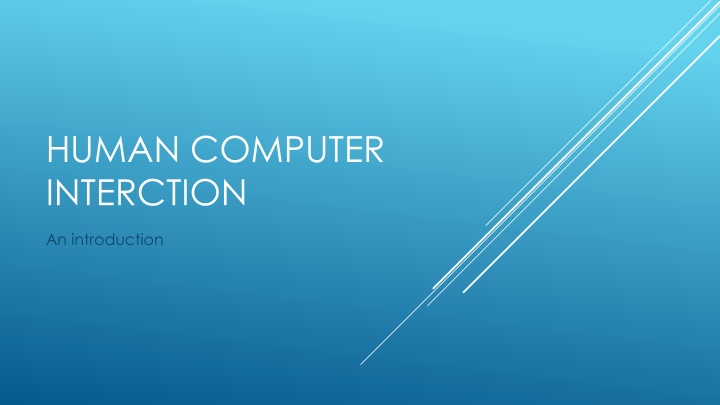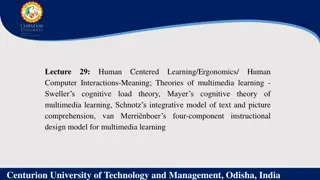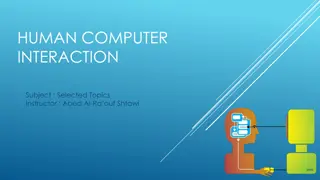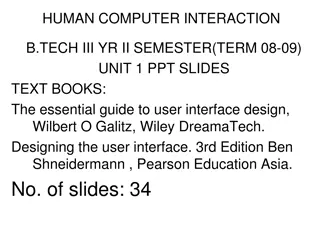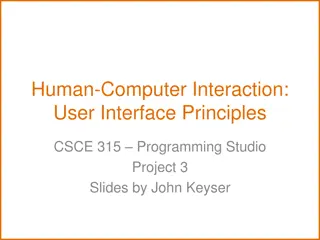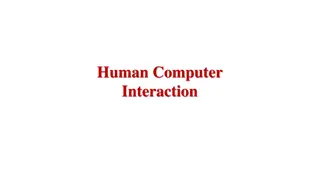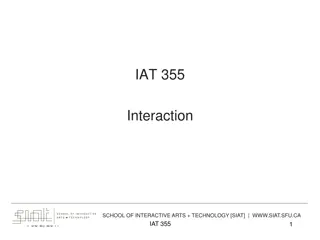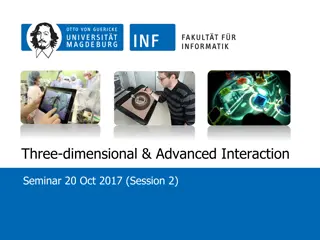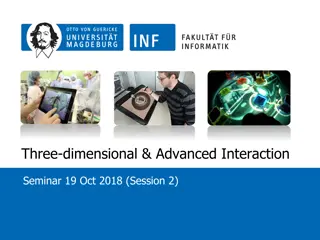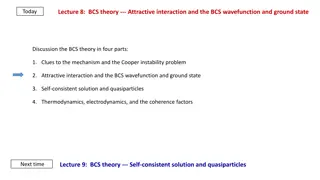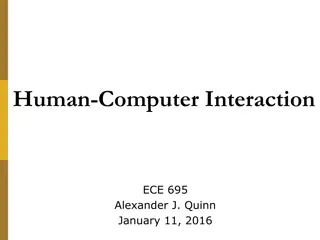Essential Interaction: Human-Computer Systems
Interacting with technology has become vital in everyday life. The design of computer systems must prioritize usability to ensure users can easily achieve tasks. Human-Computer Interaction (HCI) focuses on user-friendly interfaces and efficient interactions between people and technology.
Download Presentation

Please find below an Image/Link to download the presentation.
The content on the website is provided AS IS for your information and personal use only. It may not be sold, licensed, or shared on other websites without obtaining consent from the author.If you encounter any issues during the download, it is possible that the publisher has removed the file from their server.
You are allowed to download the files provided on this website for personal or commercial use, subject to the condition that they are used lawfully. All files are the property of their respective owners.
The content on the website is provided AS IS for your information and personal use only. It may not be sold, licensed, or shared on other websites without obtaining consent from the author.
E N D
Presentation Transcript
HUMAN COMPUTER INTERCTION An introduction
Interacting with technology has become an essential part of everyday life for the majority of people. The average user of a computer system is now less likely to understand the technology. Since, there are different types of technology they have to use. People are busy and may spend little or no time actually learning a new system. INTRODUCTION 2
Therefore, computer systems should be easy to use, easy to learn, and with no errors. To design and develop of such a system is a major concern of HCI 3
The ultimate goal of design in HCI is to create interfaces that are both useful and useable. Useful means that the interface allows the user to achieve some task, but usefulness is a pretty low bar. For example, a map is useful in finding your way from one place to another, but it isn't the most useable thing in the world. USEFUL AND USABLE
So our big concern is usability. That's where we get things like navigation apps. Notice how we have to focus on understanding the task when we're performing design. If we set out to design a better map we don t make it usable It was through understanding the task of navigation itself that we realized we could offload a lot of the cognitive load of navigation onto the interface, closing the loop between the user and the task of navigation.
Human-computer interaction (HCI): is a discipline concerned with the design, evaluation and implementation of interactive systems for human use and with study of major phenomena surrounding them. WHAT IS HCI?
HCI (human-computer interaction) is the study of interaction between people (users) and computers. Interaction between users and computers occurs at the user interface The golden principle in HCI is that people should come first . (TO BE DISCUSS!!) WHAT IS HCI? 7
HCI consists of three parts: Human: could be an individual user or a group of users. Computer: could be any technology ranging from the general desktop computer to a large scale computer system. Interaction: any direct or indirect communication between a human and computer. 8
A human interact with the environment through different senses (complexity keyboard VR) A human has memory, experience, skills, knowledge
In HCI all the elements have to be taken into account
The human interact with the computer (simplistic scenario) The computer interacts with a task through a computer (real scenario) Goal: make the interface almost invisible
HCI concentrates on the study of human factors The study of human factors started during the Second World War by US army. Usability was born because of badly designed arms that caused friendly fire during war. It was during war time that the value of human factors and ergonomics was recognised as a great way to create more efficient and effective soldiers, i.e. better killing machines. Our usability predecessors spent their days working on the battleground, ensuring that soldiers could get on with their daily tasks in the most optimal manner. What kinds of things did they do? Their work involved much more focus on human factors and ergonomics, taking into account the effects of workload, fatigue, physical task design, mental workload, teamwork, environmental effects. It was during the second world war, that practitioners expanded their focus to aircraft and how through more intuitive design of airplane cockpits, pilot error could be greatly reduced. 13
Making the interface look pretty Only about desktop computers (and that goes for computing as well!) Something that would be nice to do but usually there s no time for it HCI IS NOT ABOUT 15
Understanding the users Understanding users tasks Understanding the surrounding environment Design prototype Evaluate the system HCI IS ABOUT 16
The goal of HCI is to develop or improve the safety, utility, effectiveness, efficiency and usability of system that include computers. (Interacting with computers, 1989, p3) THE GOALS OF HCI 17
The words effective and efficient both mean "capable of producing a result," but there is an important difference. A usable system is: easy to use easy to learn Effective means "producing a result that is wanted". easy to remember how to use effective to use Efficient means "capable of producing desired results without wasting materials, time, or energy". efficient to use safe to use enjoyable to use WHAT IS USABILITY? 18
Mihaly Csikszentmihalyi La felicit quel particolare stato della mente nel quale si chiamati ad affrontare una sfida riuscendo a completare il task. PERCH SI GIOCA? TRA GLI ALTRI MOTIVI: FELICIT DI FLUSSO
1.Intense and focused concentration on the present moment 2.Merging of action and awareness 3.A loss of reflective self-consciousness 4.A sense of personal control or agency over the situation or activity 5.A distortion of temporal experience, one's subjective experience of time is altered 6.Experience of the activity as intrinsically rewarding, also referred to as autotelic experience
A Good user-interface can: 1. Earn a company billions. 2. Increase users loyalty. 3. Increase users trust. 4. Makes users happy : ) WHY IS USABILITY IMPORTANT? 21
Can Preventing accidents 1. Health and safety concerns 2. Can reduce the cost of customer training and support 3. Direct correlation between HCI and sales 4. THE IMPORTANCE OF HCI 22
A Bad user-interface can: 1. be annoying, frustrating, and even deadly. 2. Increase mistakes in data entry and system operation. 3. Makes functions become completely inaccessible. 4. System failure because of user rejection. 23
Competition is very close (just another link) Comparison is easily possible (example Online-Shop) Users who can t find the product in the shop can not buy it Users who are not able to fill in correctly the order form are not going to buy WHY HCI IS IMPORTANT IN THE CONTEXT OF WWW? 24
Basic misconceptions: If I (the developer) can use it, everyone can use it If our non-technical staff can use it, everyone can Good user interfaces are applied common sense A system is usable if all style guidelines are met IT IS NOT SIMPLE TO MAKE GOOD USER INTERFACES 25
EXAMPLES OF GOOD AND BAD DESIGN 26
DISCIPLINES CONTRIBUTING TO HUMAN-COMPUTER INTERACTION 31
1) If the video doesnt record a TV program because we pressed the wrong button, we are likely to feel angry. 2) A real example: a pilot shuts down the wrong engine and the plane crashes (as happened Leicestershire, in England on the M1 motorway in 1989), this is obviously more serious. 47 died near A REAL L FE EXAMPLE 32 https://it.wikipedia.org/wiki/Volo_British_Midland_92
Fact - Fletcher Buckley (Member board of IEEE) : 85% of Software projects are either late or delivered without satisfying the specification. But WHY? 33
Projects in general fail for various reasons: lack of senior management commitment lack of user involvement lack of user requirements specifications poor project planning and team problems REASONS FOR FAILURES 34
Is concerned with producing software, software specification, maintainability, and testing Generally considers the interface to be just another software component. TRADITIONAL APPROACHES TO SYSTEM DEVELOPMENT 35
requirements analysis encompasses those tasks that go into determining the needs or conditions to meet for a new or altered product or project, taking account of the possibly conflicting requirements of the various stakeholders, analyzing, documenting, validating and managing software or system requirements Requirements specification The waterfall model Analysis Design Software design Software design may refer to either "all the activity involved in conceptualizing, framing, and ultimately modifying complex systems" or "the activity following requirements specification and before programming, in a stylized software engineering process." Software design usually involves problem solving and planning a software solution. This includes both a low-level component and algorithm design and a high-level, architecture design (ex. car simulator). Implementation Testing Operation and maintenance EXAMPLE OF TRADITIONAL APPROACH 36
This approach normally involves a number of key activities throughout the development of the software including: Involving users Obtaining their feedback on the design Providing prototypes for system evaluation and re- design in light of user feedback and comments. INTRODUCTION TO USER CENTERED APPROACH 37
THE LIFE CYCLE FOR INTERACTIVE SYSTEMS Requirements specification user needs Analysis Design Implementation Testing 38 Operation and maintenance
TIPS TO IDENTIFY THE TASK Start to identify the smallest operations in each task (decompose) Keep asking why they are performing a specific action Live behind your previous experince
USER CENTERED DEVELOPMENT STEPS TO PERFORM Data Collection 1. Data Analysis 2. Prototyping 3. Design 4. Evaluation 5. 40
Data recording Using media Interviews Stakeholder interviews User and customer interviews Questionnaires Surveys, product reviews Literature review Studying existing systems 1. DATA COLLECTION 41
Advantages of Prototyping: Users are actively involved in the development It provides a better system to users Errors can be detected much earlier Quicker user feedback is available leading to better solutions 3. PROTOTYPING 42
Testing the usability, functionality and acceptability of an interactive system Expert evaluation A subject-matter expert (SME) or domain expert is a person who is an authority in a particular area or topic Evaluation by Subject Matter Experts User evaluation Evaluation by user or customer 5. EVALUATION 43
L SHAPE REACTION TIME (REMOTED MONITORED)
DESIGNER VS. USERS Why this photocopier does not work? Designer meant by C = Clear People thought that C = Copy 46
